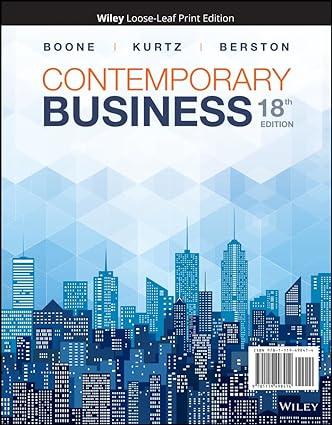While on vacation in the Middle East, entrepreneur Lisa Mendelson witnessed a group of American tourists sampling
Question:
While on vacation in the Middle East, entrepreneur Lisa Mendelson witnessed a group of American tourists sampling halvah at an outdoor marketplace. The experience immediately brought back childhood memories of this confection made from sesame seeds, nuts, and sugar, with the flakiness found inside a Butterfinger candy bar.
Mendelson returned to New York with a vision to take a couple of ancient Middle East food products and modernize them in the United States. The result is Seed + Mill, an artisanal food stall in New York City's famous Chelsea Market that sells tahini, much like a rich and creamy nut spread, and halvah, both of which are made from sesame seeds.
Mendelson did not execute her vision of healthy and artisanal sesame food products without first thinking about how she would finance her venture selling popular Middle Eastern and Mediterranean food staples in the United States. Whether a business is large or small, financial management and identifying short-term and longer-term funding options can be a challenge. It requires longrange thinking and planning—and diligence, creativity, and discipline.
Mendelson knew that executing her vision would require money. She and her two partners decided to seek individual investors—often called angel investors—who shared their vision and passion. After sending out Seed + Mill's business plan and many rejections later, two investors who shared the same passion for tahini and halvah became a part of Seed + Mill, the only store in the United States solely dedicated to sesame seed products. To date, there are a total of five investors, including the three active partners.
Lisa Mendelson is a serial entrepreneur, and Rachel Simons was previously a human resources lawyer. However, at the heart and soul of Seed + Mill's finance operation is Monica Molenaar, who possesses a graduate degree in business from Stanford University.
Monica built the company's financial model and continues to come up with and evaluate ideas for financing options. The partners agreed to avoid any sources of traditional bank or venture capital funding, choosing instead personal investors more closely connected with their mission of on-site milling of tahini with the highest-quality Ethiopian sesame seeds.
The company's financial plan, like most, is a document that specifies the funds needed by the company for a given period of time, the timing of inflows and outflows, and the most appropriate sources and uses of funds. Monica admits that building a financial plan was a challenge at the beginning. Because Seed + Mill imports halvah from Israel, stores it in nearby Brooklyn, and then transports it to the company's food stall, each of the stages of the supply chain is not only costly, but also time consuming. Monica visits the financial plan on an ongoing basis—which is critical to making sure that Seed +
Mill is on target and close to plan.
The most interesting challenge for Seed + Mill has been managing cash flow—due mainly to the amount of time it takes to actually produce the products and have them sent by sea from Israel to New York. All in all, it takes about eight weeks from start to finish, so while Seed + Mill generates cash from daily operations through the sale of its goods in Chelsea Market, advance payment is required to purchase goods that will arrive eight weeks later. The timing of cash inflows and outflows is an integral part of Seed + Mill's financial management efforts. Built into the company's financial plan is a buffer—extra money for unforeseen emergencies or expenses—
which, Monica admits, has been exercised.
As Seed + Mill's financial manager, Monica manages funds to make sure that sufficient money is available for daily operations and capital investments. Cash flow and borrowing needs are evaluated on an ongoing basis—and close attention is paid to return on investment, cost of funds, and interest rates.
To date, Seed + Mill has shown a profit, and with continued growth into wholesale operations and its products available on Amazon.com, the partners remain optimistic. Their current location in New York's Chelsea Market, which attracts more than 6 million visitors annually, is a big plus. Growth requires financing, and the initial goal of Seed +
Mill was to “walk before we run” by getting the food stall up and running—and to determine whether people liked the products.
“We're going to start running,” says Monica, “and there's a lot of work that needs to go into it to get ourselves conditioned for that sprint.” Whether or not the partners decide to sell out, merge with a larger company, or grow by franchising, one thing remains true: the potential growth of Seed + Mill is “Open Sesame.”
Questions for Critical Thinking 1. In five years, Mendelson hopes to see tahini on every kitchen table. What would be the most appropriate source of largescale funding if Mendelson's vision becomes a reality? Might the newfound passion for the flavors of the Middle East help the company in its funding efforts?
2. Seed + Mill chose to pursue individual investors rather than venture capital firms or banks. Discuss why you believe this decision was made and its impact upon future expansion plans.
3. The mix of debt and equity capital is known as a company's capital structure. Based on what you know, evaluate Seed +
Mill's current capital structure. What changes might occur to its capital structure as tahini and halvah are modernized and become more well-known in the United States?
4. What types of companies or suppliers might have an interest in either merging or acquiring Seed + Mill? What would be the benefit to Seed + Mill of a merger or acquisition? Discuss both options as they apply to Seed + Mill in terms of the company's growth.
Step by Step Answer:

Contemporary Business
ISBN: 9781119498414
18th Edition
Authors: Louis E. Boone, David L. Kurtz, Susan Berston





